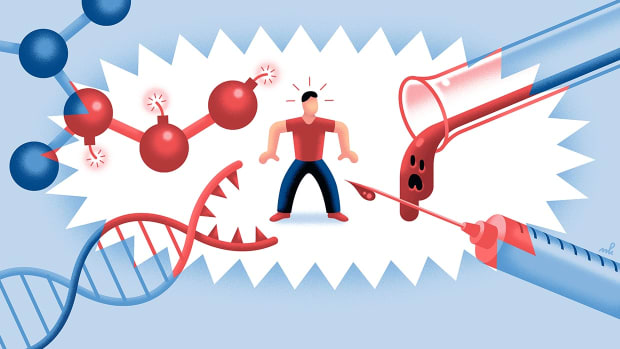
“A new epidemic is on its way, with pandemic potential”, says UvA PhD student
Livestock farming is a source of known and unknown viruses. Therefore, virus research in farm animals is becoming increasingly important to prepare in time for possible pandemics. UvA PhD student Alba Folgueiras González researched it. “Viruses such as influenza are the biggest threat.”
Farm animals, such as pigs and poultry, are a source of pathogens such as influenza virus. These types of viruses mutate rapidly, can pass from animals to humans and therefore pose a huge risk to public health. PhD student Alba Folgueiras González researched livestock viruses and their hidden threats.

What makes the emergence of viruses so unpredictable? What role exactly does intensive livestock farming play in this? And should we prepare for a new pandemic? Five questions to González.
What makes it difficult to control viruses like avian flu?
“Especially in the scientific community, it is well known that the influenza viruses, which include seasonal flu but also avian flu or swine flu are difficult to control. While rare, the last two have also shown to be able to infect humans. Influenza viruses are known to spread very quickly through droplets made when people with flu cough, sneeze, or talk. In addition, influenza viruses mutate very often, as well as other viruses such as SARS-CoV-2. That makes it very difficult to get a grip on its spread.”
“Take, for example, the flu virus for which the elderly can be vaccinated annually. What many people don’t know is that this vaccine has to be remade every year because the virus changes and new variants emerge. We do this based on predictions and developments in other parts of the world, but each time it remains uncertain to what extent the vaccine will work.”
“In addition, developing a vaccine takes time, time in which a virus can already develop beyond the knowledge with which we want to make the vaccine. That makes getting an outbreak under control enormously difficult.”
The avian flu variant H5N1 has been gripping for several years and has now led to 889 human infections and 463 deaths
worldwide. Earlier this month, the first human death due to H5N2 was reported in Mexico. Last week, the European Commission reported having procured 665,000 vaccines to prevent a possible bird flu pandemic among humans.
Is every virus equally dangerous?
“What I make very clear in my thesis is that viruses are not necessarily malignant. We know that there are numerous viruses present in our bodies, and in those of animals, which, for example, interact with the microbiome in the intestines and can be beneficial. There are also numerous viruses in the ocean and in the soil that are not a public health hazard.”
“Regarding human viruses, not all of them are equally dangerous. Many viruses don’t aim to kill their hosts quickly because they can have a broader impact by keeping their hosts alive, allowing for prolonged spread within the community. For example, the influenza virus spreads easily through air droplets and can mutate into new variants, leading to large-scale pandemics. Conversely, the Ebola virus is highly lethal but spreads primarily through direct contact with bodily fluids. Because Ebola causes severe symptoms that quickly incapacitate its victims, it’s less likely to spread widely, making outbreaks easier to control.”
“Livestock farming is a reservoir for new pandemics,” you write in your thesis.
“True. Avian flu, swine flu and SARS-CoV-2 are all three examples of zoonoses - viruses passed from animals to humans - that can be traced back to an animal reservoir. The worrying thing is that, human diseases have been widely studied and we know a lot about them, but for animal diseases we may only know the tip of the iceberg. There may be still many virus variants yet to be discovered but which could pose a risk to public health We like to refer to all these amount of unidentified and uncharacterized virus genetic information as viral dark matter. ”
“As I mentioned earlier, humans and animals carry all kinds of viruses that are not necessarily harmful initially. This makes it incredibly difficult to pick out the pathogens; you are looking for a needle in a haystack. In addition, animals (as well as humans) do not always show symptoms that they are sick. In such scenarios we have hardly any information about the presence of possible harmful viruses.”
“Fortunately, technology has advanced a lot in the last years. For instance, Next Generation Sequencing is a widely used method nowadays which we can use to identify and read genetic material at lightning speed. We are increasingly able to link the bits of information we find to existing or parts of existing viruses better and faster using large databases and bioinformatic tools. In the case of viruses this information is very important to make vaccines.”
That sounds like symptom control. Shouldn’t we change something fundamental about the scale of livestock production?
“I think we definitely need to rethink some things when it comes to intensive livestock farming. But we should not forget that it also plays an important role in the global food supply. One issue is that farmers might be reluctant to report diseases due to the fear of losing their livestock and subsequent production due to measures by health authorities. More engagement between the agriculture industry and scientific research is crucial to detect and stop infectious diseases before they can pose a risk to public health.”
“In addition, animal husbandry is not the only source of infectious diseases. Given people in parts of the world are expanding into new areas such as rainforests, we also come into contact with new and unknown viruses via that route. So, we should not only focus on animal husbandry, where many viruses have already been discovered and managed in highly controlled environments.”
A reservoir for a pandemic, much still unknown, and time seems to be ticking. Shouldn’t we be incredibly worried?
“I think we should mostly worry about the viruses that we already know about and are constantly mutating. These are the viruses, such as (seasonal) influenza and coronavirus, that have caused the greatest dangers in the last decade, if we look at the numbers. For example, we have known corona viruses for years as causative agents of common colds. I expect it is realistic to think that between the next years, we are going to face a new epidemic from this group of viruses, and it will be in our hands to stop it there before it reaches pandemic potential.”
“At the same time, we must not forget that the SARS-CoV-2 pandemic ensured that we gained experience in many areas to be better prepared for another outbreak. Just look at the actions now of the European Union or the World Health Organisation. On a personal level, society, scientists and the pharmaceutical industry alike, we have gained knowledge of how to deal with an outbreak. In addition, with methods like Next Generation Sequencing, and vaccine platforms we can have a vaccine ready to protect us from pathogens faster than ever before. That’s really insane and something to be hopeful about.”
PhD defense Alba Folgueiras González on the thesis Virus discovery in farm animals - Uncovering hidden viral threats and their role in disease on Thursday 20 June. Starts at 4pm. Location: Agnietenkapel.

